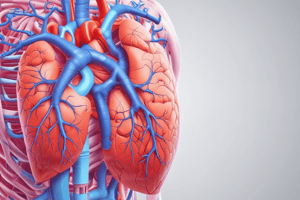Podcast
Questions and Answers
What is the primary function of the pulmonary system?
What is the primary function of the pulmonary system?
- Regulating body temperature
- Filter organisms from the blood
- Transporting nutrients to tissues
- Gas exchange between air and blood (correct)
Which muscle is primarily responsible for breathing?
Which muscle is primarily responsible for breathing?
- Latissimus dorsi
- Diaphragm (correct)
- Pectoralis major
- Rectus abdominis
What condition is characterized by decreased lung compliance?
What condition is characterized by decreased lung compliance?
- Asthma
- Bronchitis
- Emphysema
- Pneumonia (correct)
What results from hyperventilation?
What results from hyperventilation?
Which of the following is a symptom of pulmonary disease?
Which of the following is a symptom of pulmonary disease?
What is hypercapnia caused by?
What is hypercapnia caused by?
How does aging affect respiratory function?
How does aging affect respiratory function?
What causes hypoxemia?
What causes hypoxemia?
Which of the following conditions occurs due to airway obstruction?
Which of the following conditions occurs due to airway obstruction?
What is the role of accessory muscles in respiration?
What is the role of accessory muscles in respiration?
What is a primary treatment for acute respiratory failure due to hypercapnia?
What is a primary treatment for acute respiratory failure due to hypercapnia?
Which condition is characterized by air in the pleural space?
Which condition is characterized by air in the pleural space?
What is a common symptom of pulmonary edema?
What is a common symptom of pulmonary edema?
In terms of treatment, how is empyema typically managed?
In terms of treatment, how is empyema typically managed?
What is a crucial step in the management of aspiration to prevent lung complications?
What is a crucial step in the management of aspiration to prevent lung complications?
Which condition is often treated with bronchodilators and corticosteroids?
Which condition is often treated with bronchodilators and corticosteroids?
What symptom distinguishes active tuberculosis from latent tuberculosis?
What symptom distinguishes active tuberculosis from latent tuberculosis?
Which respiratory condition is specifically caused by an excessive amount of fibrous tissue?
Which respiratory condition is specifically caused by an excessive amount of fibrous tissue?
What is a defining symptom of bronchiolitis commonly seen in infants?
What is a defining symptom of bronchiolitis commonly seen in infants?
What is a common consequence of chronic obstructive pulmonary disease (COPD)?
What is a common consequence of chronic obstructive pulmonary disease (COPD)?
Flashcards are hidden until you start studying
Study Notes
Pulmonary and Bronchial Circulation
- Primary function: Gas exchange between the air and blood.
- The process involves ventilation, diffusion, and perfusion.
- Pulmonary circulation delivers deoxygenated blood to the lungs and oxygenated blood back to the heart.
Mechanics of Breathing
- Major breathing muscles include diaphragm and external intercostals.
- Accessory muscles are used when breathing is more difficult (e.g., sternomastoid, scalene).
- Elasticity and compliance are crucial for efficient breathing.
- Emphysema increases compliance (lungs inflate easily).
- Conditions like pneumonia and fibrosis decrease compliance.
- Airway resistance is influenced by airway length and diameter.
Geriatric Considerations
- Decreased chest wall compliance and elastic recoil decrease ventilatory reserve and reduce gas exchange surface area.
Symptoms of Pulmonary Disease
- Dyspnea: Labored breathing.
- Orthopnea: Difficulty breathing when lying flat (often a sign of heart failure).
- Cough: Protective reflex, can be acute or chronic.
- Hypoventilation: Can cause hypercapnia and respiratory acidosis; hyperventilation leads to hypocapnia.
Hypercapnia and Hypoxemia
- Hypercapnia: Increased CO2 due to hypoventilation.
- Hypoxemia: Reduced oxygenation of arterial blood due to ventilation-perfusion mismatch or shunting.
Acute Respiratory Failure
- Causes include direct lung injury, opioid overdose, or brain injury.
- Treatment involves ventilatory support for hypercapnia and oxygen therapy for hypoxemia.
Compromised Chest Wall Issues
- Pneumothorax: Air in the pleural space collapsing the lung.
- Treatment involves inserting a chest tube.
- Pleural effusion: Fluid accumulates in the pleural space leading to dyspnea and pleural pain.
- Treatment involves drainage.
- Empyema: Pus in the pleural space, often caused by infection.
- Treatment includes antibiotics and drainage.
Restrictive Lung Diseases
- Aspiration: Fluid or solid enters the lungs, causing inflammation and infection.
- Symptoms include choking and coughing.
- Atelectasis: Lung tissue collapse due to external pressure or surfactant impairment.
- Deep breathing exercises can prevent atelectasis.
- Pulmonary fibrosis: Excessive fibrous tissue causing reduced lung compliance.
- Management involves oxygen therapy and medications.
- Pulmonary edema: Fluid accumulation in the lungs, often caused by left-sided heart failure.
- Symptoms include dyspnea and frothy sputum.
- Treatment depends on the underlying cause.
ARDS and ALI
- Acute Respiratory Distress Syndrome (ARDS): Severe lung inflammation causing respiratory failure.
- Treatment primarily focuses on supportive care.
Obstructive Lung Diseases
- Asthma: Airway inflammation causing airway constriction and wheezing.
- Treatment involves bronchodilators and corticosteroids.
- Chronic Obstructive Pulmonary Disease (COPD): Includes chronic bronchitis (mucus production) and emphysema (alveolar destruction).
- Management includes bronchodilators, corticosteroids, and oxygen therapy.
Emphysema
- Emphysema: Lung disease with damaged alveolar walls causing air trapping.
- Impaired airflow.
Upper and Lower Respiratory Tract Infections
- Pneumonia: Infection of lower respiratory tract, diagnosed via chest X-ray.
- Treatment involves antibiotics if bacterial.
- Tuberculosis (TB): Infectious disease caused by Mycobacterium tuberculosis.
- Latent infections are asymptomatic, while active TB causes cough, weight loss, and fever.
- Treatment includes antibiotics.
Pediatric Conditions
- Croup: Viral infection causing barking cough and stridor.
- Often self-limiting.
- Aspiration: Foreign object entry into the airway.
- Bronchiolitis: Common in infants, often caused by RSV.
- Symptoms include wheezing and tachypnea.
- Cystic Fibrosis (CF): Genetic disorder causing thick mucus and chronic infections.
- Treated with chest physiotherapy and antibiotics.
Studying That Suits You
Use AI to generate personalized quizzes and flashcards to suit your learning preferences.




